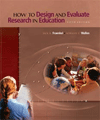 |  How to Design and Evaluate Research in Education, 5/e Jack R. Fraenkel,
San Francisco State University
Norman E. Wallen,
San Francisco State University
Validity and Reliability
Main PointsValidity - It is important for researchers to use valid instruments for the conclusions they draw are based on the information they obtain using these instruments.
- The term "validity," as used in research, refers to the appropriateness, meaningfulness, correctness, and usefulness of any inferences a researcher draws based on data obtained through the use of an instrument.
- Content-related evidence of validity refers to judgments on the content and logical structure of an instrument as it is to be used in a particular study.
- Criterion-related evidence of validity refers to the degree to which information provided by an instrument agrees with information obtained on other, independent instruments.
- A criterion is a standard for judging; with reference to validity, it is a second instrument against which scores on an instrument can be checked.
- Construct-related evidence of validity refers to the degree to which the totality of evidence obtained is consistent with theoretical expectations.
- A validity coefficient is a numerical index representing the degree of correspondence between scores on an instrument and a criterion measure.
- An expectancy table is a two-way chart used to evaluate criterion-related evidence of validity.
Reliability - The term "reliability," as used in research, refers to the consistency of scores or answers provided by an instrument.
- Errors of measurement refer to variations in scores obtained by the same individuals on the same instrument.
- The test-retest method of estimating reliability involves administering the same instrument twice to the same group of individuals after a certain time interval has elapsed.
- The equivalent-forms method of estimating reliability involves administering two different, but equivalent, forms of an instrument to the same group of individuals at the same time.
- The internal-consistency method of estimating reliability involves comparing responses to different sets of items that are part of an instrument.
- Scoring agreement requires a demonstration that independent scorers can achieve satisfactory agreement in their scoring.
|
|



 2003 McGraw-Hill Higher Education
2003 McGraw-Hill Higher Education